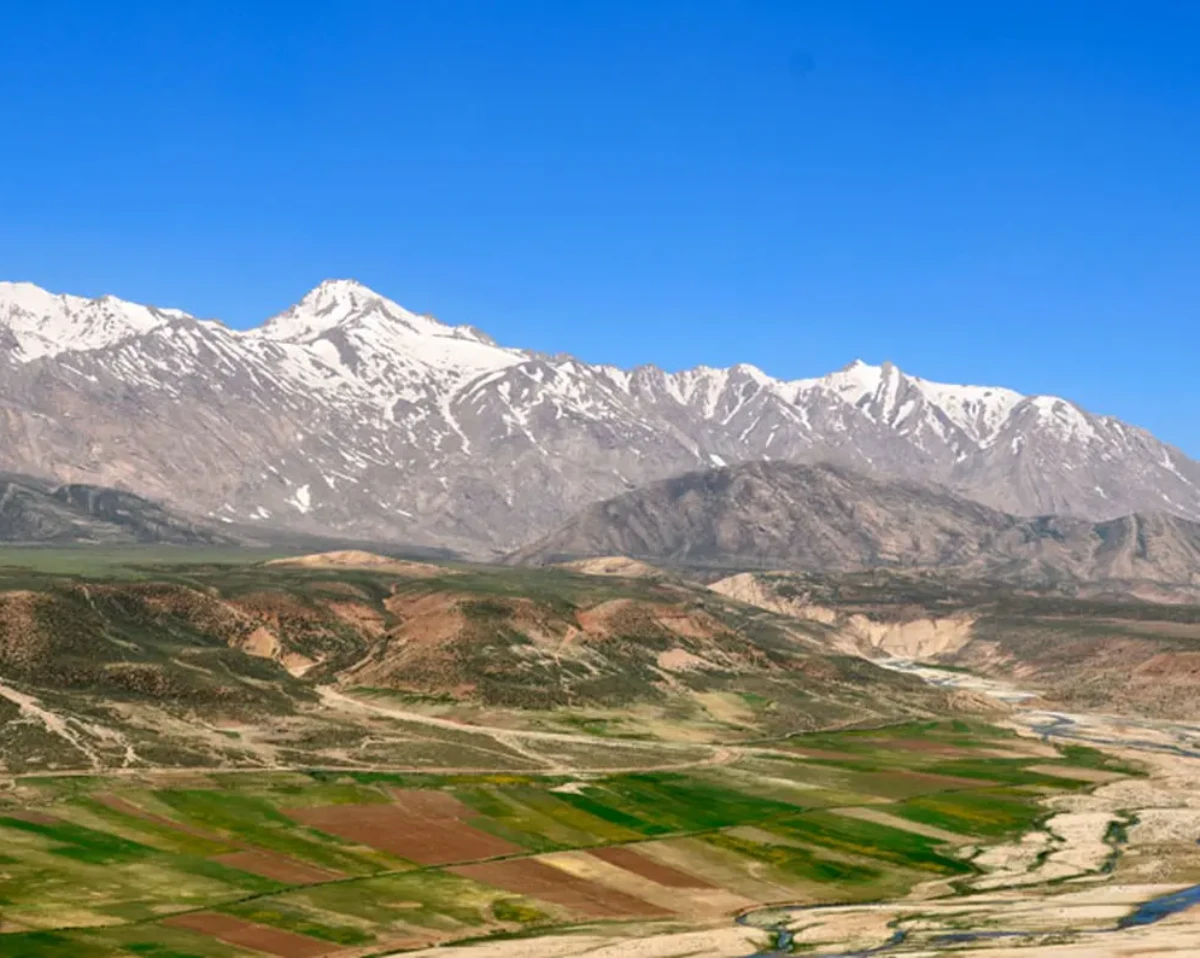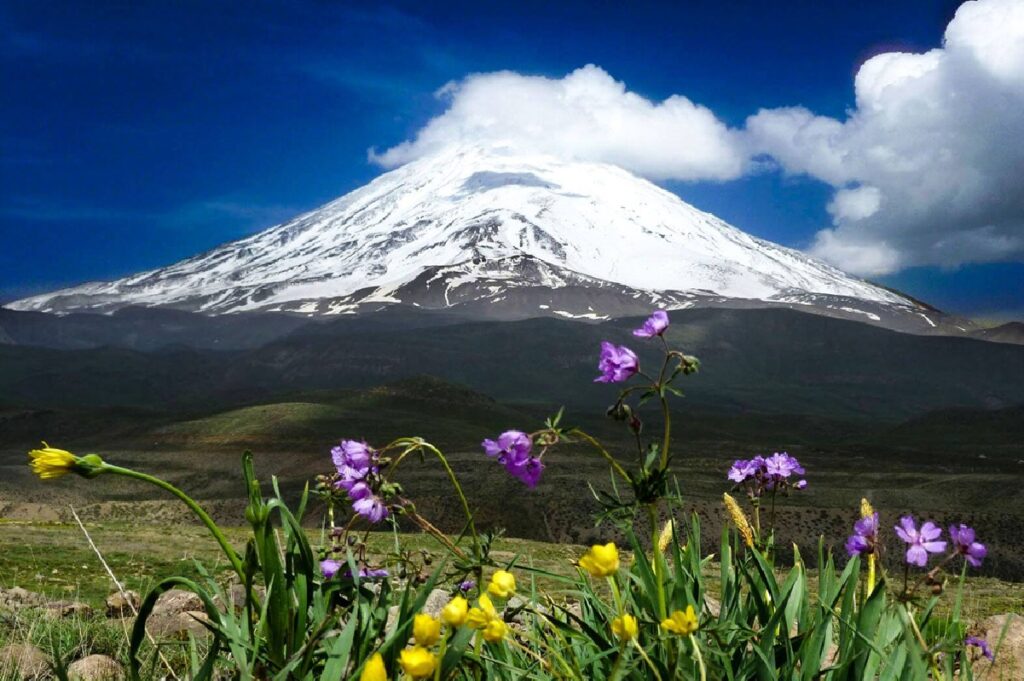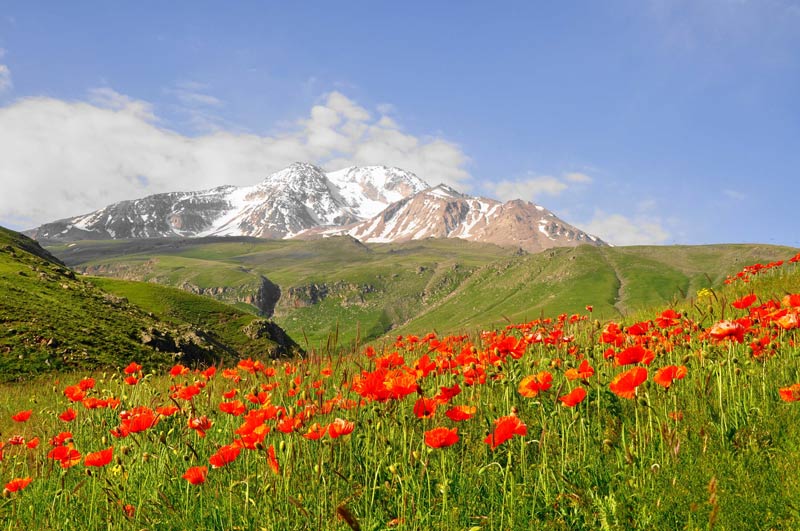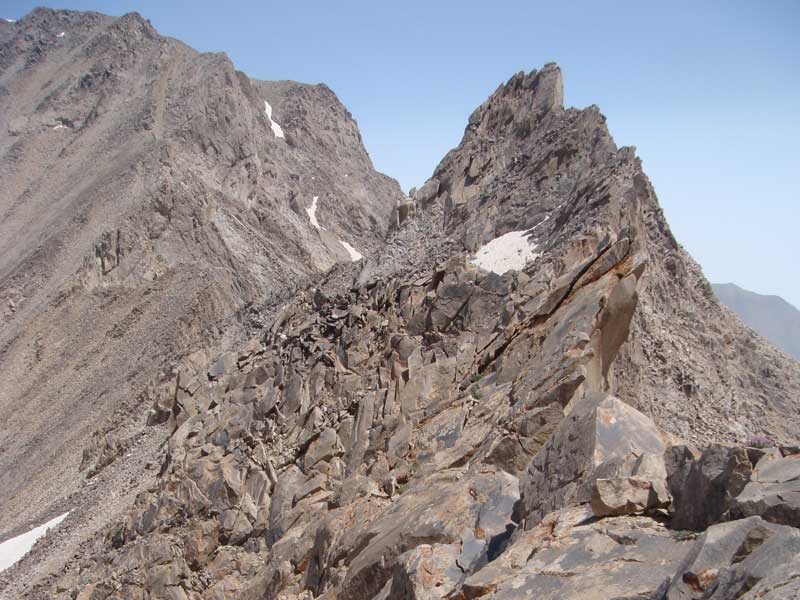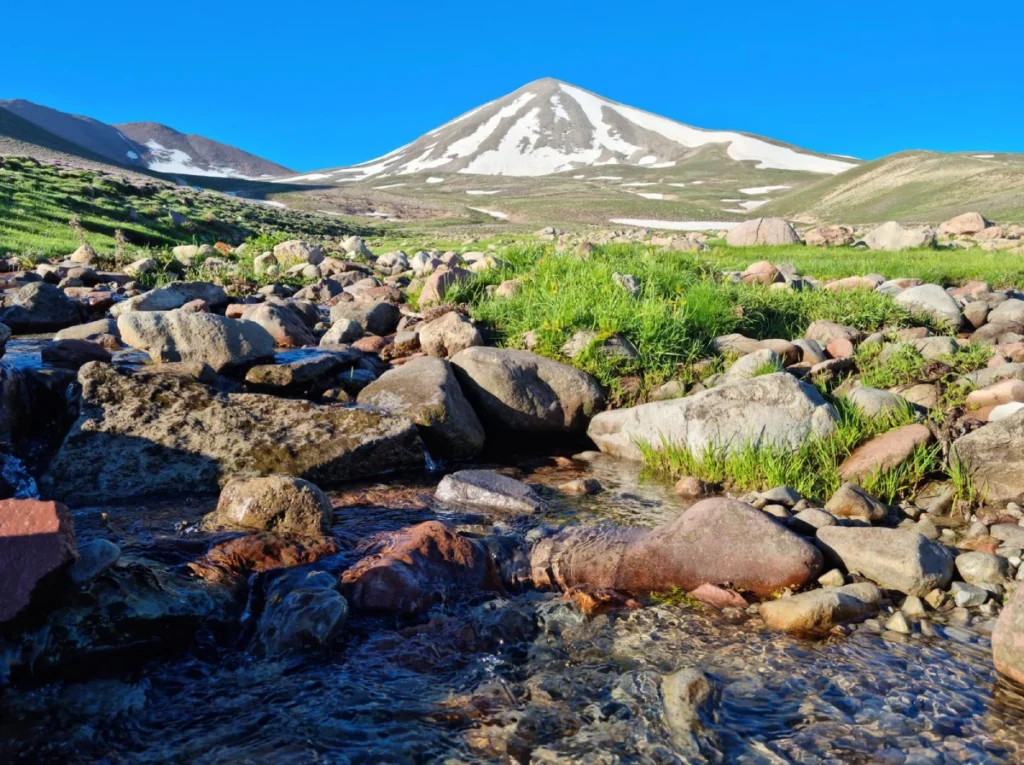Mount Zard-Kuh (literally “Yellow Mountain”) is a sub-range of the Central Zagros Mountains in Iran. Its soaring peaks reach roughly 4,220–4,300 meters, and the highest summit – Kolonchin – is the second-highest point in the Zagros (after Mount Dena). The range lies mostly in Chaharmahal and Bakhtiari Province near Shahrekord and Kuhrang. From these heights emerge Iran’s two major rivers: the Karun (the country’s longest river) and the Zayandeh Rud, which begin on its slopes.
In spring, the lower slopes burst with medicinal plants, wildflowers and grasses, and groves of hardy Zagros oaks and maples carpet the hillsides. Wildlife such as wolves, Persian leopards and mountain goats roam these steep valleys, making Zard-Kuh celebrated as one of Iran’s most breathtaking wilderness areas. Traditionally this high country is the summer pasture for the Bakhtiari nomads, who move their herds through the mountain meadows each year (the classic documentary Grass famously captured a Bakhtiari migration across Zard-Kuh’s passes).
In short, Mount Zard-Kuh is a spectacular and culturally rich landscape – one of Iran’s most scenic and significant mountain destinations.
Geology and Natural Features of Mount Zard-Kuh
Geologically, Zard-Kuh lies in the Sanandaj–Sirjan zone of the Zagros orogeny. Its jagged peaks are composed mainly of Cretaceous limestone (with bands of shale), which has been folded and uplifted into the classic ridges and cliffs of the Zagros. The mountains trend northwest–southeast across this part of Chaharmahal-Bakhtiari Province.
Despite the generally dry climate of central Iran, Zard-Kuh’s elevation creates a surprisingly wet microclimate: annual precipitation can reach 800–1,200 mm, much of it as snow. Meltwater from this snow feeds permanent glaciers and icefields on the highest slopes. Notably, the Iluk, Porsonan and Khorasan glaciers survive year-round on Zard-Kuh’s upper reaches– the only true glaciers in the Zagros. These icy reserves feed countless springs and streams even in summer.
In fact, Zard-Kuh is often cited as “one of the richest natural water reserves in Iran”: the Karun, Zayandeh Rud, Kuhrang and Bazoft rivers all begin here. This abundant water shapes the landscape – deep alpine meadows, forested gorges and alpine lakes dot the flanks. The vegetation and wildlife reflect this bounty. The lower valleys and crests support oak-maple forests and flowering meadows, far greener than the xeric foothills below. Botanists record hundreds of plant species, including the unique “Zard-Kuh oak” (Quercus brantii) found only in this range.
In spring and summer the hillsides blaze with wild tulips, lilies, thyme and mountain celery. Large mammals roam the forests and crags: wild goats, boars, wolves and even the elusive Persian leopard and Asiatic cheetah have been reported (though sightings are rare). This rich biodiversity – combined with dramatic geology – makes Zard-Kuh a natural marvel of the Zagros. The mountain’s deep valleys and steep walls, carved from limestone, also create spectacular vistas and prime habitat for raptors and other wildlife.
Climbing and Exploration of Mount Zard-Kuh
Zard-Kuh offers challenging treks and climbs, but it has few truly technical walls compared to Iran’s northern ranges. Almost all expeditions target the summit Kolonchin (4,220+ m), reached via camps in the eastern valleys. The standard approach is from the town of Chelgerd. From Chelgerd there are three common ascent routes:
Northern Ridge Route: Starts near the Kuhrang dams and climbs via the Chal Mishan area. It is long and steep, with loose limestone scrambling towards the top.
Eastern (Khadang) Route: Follows the Khadang Gorge past the second Kohrang dam. It is the fastest path in good weather but is often blocked by snow and avalanche dangers in winter.
Eastern Ridge Route: Climbs from the same side but on the ridge via the Khorasan camp. This path is typically used for winter ascents as it provides a more direct line upward.
In summer these routes involve long, strenuous hiking and steep slopes, but little technical rock climbing. Winter climbs, however, become serious undertakings: the snowfields require ice axes and crampons, and avalanche danger is high. Zard-Kuh’s challenging terrain and unpredictable weather mean that even “non-technical” routes demand careful planning. Local guides recommend establishing a base at Chal Mishan or Khorasan shelter (around 3,600–3,800 m) for acclimatization, then making a summit push early in the day. On a clear morning, one can see from Kolonchin’s peak across the Zard-Kuh range (including peaks like Shah-e Shahidan and Haft Tanan) and even view distant Dena in the southeast.
Today Mount Zard-Kuh is one of Iran’s favorite summer climbing destinations for experienced trekkers. Iranian climbing clubs often make annual trips here in mid-summer. The area even supports winter ski-touring: the nearby Chelgerd Ski Resort (at ~2,800 m) offers skiing when snowfall is sufficient. In short, exploring Zard-Kuh is an adventure: its rewards include spectacular mountain scenery, alpine wildlife, and the experience of remote wilderness, but it requires good fitness, proper gear and respect for the mountain’s challenges.
Best Time to Climb Mount Zard-Kuh
The climbing season for Zard-Kuh follows the high-altitude pattern of Iran’s mountains. Late summer and early autumn (July through September) are generally the optimal months. By this time most winter snow has melted from the main routes, and the weather is relatively stable. Iranian guides and climbing reports advise that “the best time to climb this area is in August and September”.
In those months, daytime temperatures on the mountain range from roughly 10–20°C, the trails are largely snow-free, and visibility is typically good for views. Late summer also lets climbers enjoy the alpine meadows and wildflowers while avoiding the worst heat of lower elevations.
Spring treks (May–June) are possible and attract hikers for the wildflower bloom, but conditions are more unpredictable. Late spring can still bring deep snow on upper slopes, requiring winter gear and increasing avalanche risk. If trekking in spring, one should be prepared for cold conditions, carry ice equipment and monitor the weather carefully.
Winter (November–April) on Zard-Kuh is extreme. Heavy snowfall and cold temperatures close most routes. Only very experienced alpinists attempt the peaks in winter – they use rope teams, ice climbing gear and sometimes skis. Even professional teams note that winter climbing is “very challenging, appealing and exciting”, with towering snow walls and avalanche hazard. In practice, casual trekkers and first-timers should avoid winter on Zard-Kuh.
In summary, plan a Zard-Kuh trek for late summer. August and September give the best balance of weather and route accessibilit. Always check long-range weather forecasts and allow extra time for unexpected delays, as mountain storms can occur even in summer.
Safety and Travel Tips for Zard-Kuh Trekking
Hire a guide or join a tour. Zard-Kuh is remote and rugged. Local mountain guides or organized tours greatly improve safety, since they know the terrain and weather patterns. Even Iranian sources warn that Zard-Kuh winter routes require advanced skills, so beginners should never climb solo.
Acclimatize properly. The summit is above 4,200 m. Build your trek with stages: many teams sleep overnight at the Chal Mishan or Khorasan shelters (around 3,600–3,800 m) before attempting the top. Stay hydrated and climb slowly to minimize altitude sickness.
Pack proper gear. The trails are steep and may hold snow. Sturdy hiking boots and trekking poles are essential. In summer the normal routes are non-technical, but if your trek extends into late autumn or spring you must pack ice axes, crampons and a rope, as snowfields and ice appear above ~3,500 m. Always carry warm layered clothing, a waterproof rain jacket, a quality tent and sleeping bag, plus sunglasses and sunscreen (the sun is strong at high altitude).
Watch weather and avalanche risk. The Zagros weather can change rapidly. Check forecasts frequently, and aim to start summit climbs early in the morning. Avoid traversing or crossing gullies after fresh snow. Local climbers recommend the mid- to late-summer window (August–September) for minimal avalanche hazard. If heavy snow is on the ground, turn back and reevaluate.
Travel logistics. The usual approach is via Shahrekord (the provincial capital) to Chelgerd. From Chelgerd a side road leads to the second Koohrang tunnel (about 10 km of dirt road)– this is the common trailhead. For context, Chelgerd is about 200 km west of Isfahan. There is no strict “climbing permit” for Zard-Kuh, but you should travel in groups, carry passports/visas, and inform local authorities or rangers of your plan.
Respect local culture. The Bakhtiari tribes live in these mountains year-round. They are famed for their hospitality and cultural traditions. Follow local customs: dress modestly in villages, ask permission before photographing people or nomadic camps, and consider hiring local muleteers or donkeys to help with camping gear. Tipping guides or helpers (even a small amount) is customary in Iran and appreciated.
FAQs
How difficult is climbing Mount Zard-Kuh?
Even in summer, Zard-Kuh is a strenuous trek. The routes involve long days of steep uphill hiking at high altitude (4,000+ m) with exposed ridgelines and loose rocks. While the summer routes are not technical rock climbs, they demand excellent fitness and good trail skills. Winter climbs are very difficult, requiring ice gear and avalanche expertise. In short, treat Zard-Kuh as a serious expedition – not a casual hill walk.
Do I need a permit or guide for Zard-Kuh?
There is no special national “permit” required to climb Zard-Kuh beyond the standard tourist visa you use in Iran. However, the region’s remoteness means that hiring a licensed guide or tour company is strongly recommended for safety and logistics. Local guides can arrange transport, lodging and mule support, and help in an emergency. Foreign trekking groups should register their itinerary with local authorities or the police, and always travel with proper documentation. In general, informed planning and respect for local regulations make a trek to Zard-Kuh much smoother and safer.

